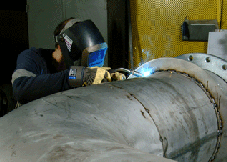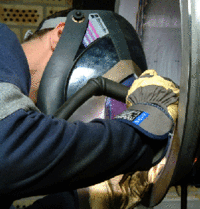
Protecting the weld
The primary tasks of a shielding gas are to protect the molten pool from the influence of the atmosphere, i.e. from oxidation and nitrogen absorption, and to stabilise the electric arc. The choice of gas can also influence the characteristics of the arc.
MIG welding
Besides the development of welding machines, the use of shielding gases contributes to increased efficiency in the MIG method. This has led to greater usage of MIG welding.
The basic gas for MIG welding is inert - argon (Ar) or helium (He), or a mixture of both. However, small additions of oxygen (O2) or carbon dioxide (CO2) can further stabilise the arc, improve the fluidity and also improve the quality of the weld deposit. For stainless steels there are also gases available containing small amounts of hydrogen (H2).

TIG and plasma welding
The normal gas for TIG welding is argon or helium, or a mixture. In some cases nitrogen (N2) and/or hydrogen (H2) is added in order to achieve special properties. For instance, an addition of hydrogen can be used for many conventional stainless steels to increase productivity. Ferritic steels and duplex steels must not be welded with shielding gases containing hydrogen. Alternatively, if nitrogen is added, the weld deposit properties can be improved. Oxidising additions are not used because they destroy the tungsten electrode.





